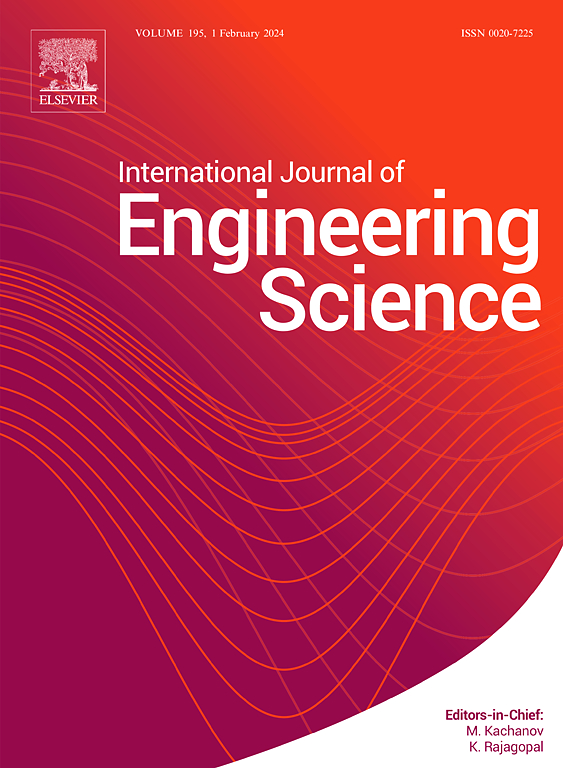Network yield and detangling as a tool for modeling back-stress network softening: A thermodynamically consistent model for polycarbonate
IF 5.7
1区 工程技术
Q1 ENGINEERING, MULTIDISCIPLINARY
International Journal of Engineering Science
Pub Date : 2025-06-11
DOI:10.1016/j.ijengsci.2025.104322
引用次数: 0
Abstract
A continuum thermodynamic constitutive model is developed to predict the large-deformation response of glassy polycarbonate (PC) across a broad range of thermo-mechanical loading conditions. It integrates both slow- and fast-relaxing components, enabling it to capture responses from quasi-static to dynamic loading. The slow-relaxing component features a novel back-stress element that evolves due to network disentanglement. This element is designed to yield under load and soften to reproduce new experimental results showing gradual softening of the kinematic hardening slope during progressively expanding cyclic loading. This thermodynamically consistent model proposes heat dissipation that captures the experimentally estimated adiabatic temperature rise in new cyclic shear tests. The elastic response of the model is engineered to reproduce the observed deformation-induced change in elastic anisotropy, and the flow indicates the emergence of both anisotropic yield and flow. The model reproduces responses observed by others in tension and compression across a wide range of strains, strain rates, and temperatures. It also captures stress relaxation following large deformation, strain recovery after loading and unloading, and ratcheting during cyclic tensile loading.
作为模拟背应力网络软化的工具:聚碳酸酯的热力学一致模型
建立了一个连续的热力学本构模型来预测玻璃状聚碳酸酯(PC)在广泛的热机械加载条件下的大变形响应。它集成了慢速和快速放松组件,使其能够捕获从准静态到动态加载的响应。缓慢放松组件的特点是由于网络解缠而演变的新型背应力元件。该元件被设计为在载荷下屈服和软化,以重现新的实验结果,显示在逐渐扩大的循环加载过程中,运动硬化边坡逐渐软化。这种热力学一致的模型提出了在新的循环剪切试验中捕获实验估计的绝热温升的散热。模型的弹性响应被设计为再现观测到的变形引起的弹性各向异性变化,流动表明各向异性屈服和流动的出现。该模型再现了其他人在大范围的应变、应变率和温度下在拉伸和压缩中观察到的响应。它还捕获大变形后的应力松弛,加载和卸载后的应变恢复,以及循环拉伸加载期间的棘轮。
本文章由计算机程序翻译,如有差异,请以英文原文为准。
求助全文
约1分钟内获得全文
求助全文
来源期刊

International Journal of Engineering Science
工程技术-工程:综合
CiteScore
11.80
自引率
16.70%
发文量
86
审稿时长
45 days
期刊介绍:
The International Journal of Engineering Science is not limited to a specific aspect of science and engineering but is instead devoted to a wide range of subfields in the engineering sciences. While it encourages a broad spectrum of contribution in the engineering sciences, its core interest lies in issues concerning material modeling and response. Articles of interdisciplinary nature are particularly welcome.
The primary goal of the new editors is to maintain high quality of publications. There will be a commitment to expediting the time taken for the publication of the papers. The articles that are sent for reviews will have names of the authors deleted with a view towards enhancing the objectivity and fairness of the review process.
Articles that are devoted to the purely mathematical aspects without a discussion of the physical implications of the results or the consideration of specific examples are discouraged. Articles concerning material science should not be limited merely to a description and recording of observations but should contain theoretical or quantitative discussion of the results.
 求助内容:
求助内容: 应助结果提醒方式:
应助结果提醒方式:


